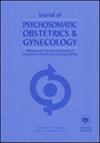Patient-specific affect-abdominal pain interactions in endometriosis: an experience sampling method (ESM) study
IF 2.1
3区 医学
Q2 OBSTETRICS & GYNECOLOGY
Journal of Psychosomatic Obstetrics & Gynecology
Pub Date : 2022-03-28
DOI:10.1080/0167482X.2022.2053844
引用次数: 4
Abstract
Abstract Objectives Cross-sectional studies show that endometriosis-related pain is associated with affect. Measuring these symptoms in real-time in a longitudinal perspective yields the ability to analyze the temporal relationship between variables. The aim was to evaluate the association between affect and abdominal pain, using the Experience Sampling Method (ESM) as a real-time, randomly repeated assessment. Methods Thirty-four endometriosis patients and 31 healthy subjects completed up to 10 real-time self-assessments concerning abdominal pain and affective symptoms during seven consecutive days. Results Endometriosis patients experienced more abdominal pain and negative affective symptoms, and scored lower on positive affect compared to healthy controls. A significant association was found between abdominal pain and both positive and negative affect in endometriosis patients. For healthy controls, less strong or non-significant associations were found. When looking at abdominal pain as a predictor for affect and vice versa, we found that only in endometriosis patients, pain was subsequently accompanied by negative affect, and positive affect may alleviate pain in these patients. Conclusions This study confirms a concurrent and temporal relationship between affect and abdominal pain in endometriosis patients and supports the use of real-time symptom assessment to interpret potential influencers of abdominal complaints in patients with endometriosis.子宫内膜异位症患者特异性影响-腹痛相互作用:经验抽样方法(ESM)研究
目的横断面研究表明,子宫内膜异位症相关疼痛与情感相关。从纵向角度实时测量这些症状可以分析变量之间的时间关系。目的是评估情绪与腹痛之间的关系,使用经验抽样法(ESM)作为实时、随机重复的评估。方法34例子宫内膜异位症患者和31名健康者在连续7天内完成多达10项关于腹痛和情感症状的实时自我评估。结果与健康对照组相比,子宫内膜异位症患者经历了更多的腹痛和负面情绪症状,并且在积极情绪方面得分较低。子宫内膜异位症患者腹痛与积极和消极影响之间存在显著关联。在健康对照中,发现了不太强烈或不显著的关联。当我们将腹痛作为情绪的预测因素,反之亦然时,我们发现只有在子宫内膜异位症患者中,疼痛随后会伴随着负面情绪,而积极情绪可能会减轻这些患者的疼痛。结论:本研究证实了子宫内膜异位症患者的情绪与腹痛之间存在同步和时间关系,并支持使用实时症状评估来解释子宫内膜异位症患者腹部主诉的潜在影响因素。
本文章由计算机程序翻译,如有差异,请以英文原文为准。
求助全文
约1分钟内获得全文
求助全文
来源期刊
CiteScore
6.10
自引率
3.20%
发文量
54
审稿时长
>12 weeks
期刊介绍:
The Journal of Psychosomatic Obstetrics and Gynecology was founded in 1982 in order to provide a scientific forum for obstetricians, gynecologists, psychiatrists and psychologists, academic health professionals as well as for all those who are interested in the psychosocial and psychosomatic aspects of women’s health. Another of its aims is to stimulate obstetricians and gynecologists to pay more attention to this very important facet of their profession.

 求助内容:
求助内容: 应助结果提醒方式:
应助结果提醒方式:


